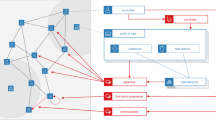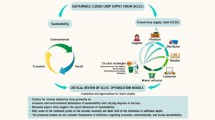Abstract
In this paper, we present a supply chain network model with multiple tiers of decision-makers, consisting, respectively, of manufacturers, distributors, and retailers, who can compete within a tier but may cooperate between tiers. We consider multicriteria decision-making for both the manufacturers and the distributors whereas the retailers are subject to decision-making under uncertainty since the demands associated with the product are random. We derive the optimality conditions for the decision-makers, establish the equilibrium conditions, and derive the variational inequality formulation. We then utilize the variational inequality formulation to provide both qualitative properties of the equilibrium product shipment, service level, and price pattern and to propose a computational procedure, along with convergence results. This is the first supply chain network model to capture both multicriteria decision-making and decision-making under uncertainty in an integrated equilibrium framework.
Similar content being viewed by others
References
Arnold, J.R.T. 2000. Introduction to Materials Management, 3rd edition. Upper Saddle River, New Jersey: Prentice Hall.
Anupindi, R. and Y. Bassok. 1996. “Distribution Channels, Information Systems and Virtual Centralization.” In Proceedings of the Manufacturing and Service Operations Management Society Conference, pp. 87–92.
Bazaraa, M.S., H.D. Sherali, and C.M. Shetty. 1993. Nonlinear Programming: Theory and Algorithms. New York; John Wiley & Sons.
Beamon, B.M. 1998. “Supply Chain Design and Analysis: Models and Methods,” International Journal of Production Economics 55, 281–294.
Bovet, D. 2000. Value Nets: Breaking the Supply Chain to Unlock Hidden Profits. New York: John Wiley & Sons.
Bramel, J. and D. Simchi-Levi. 1997. The Logic of Logistics: Theory, Algorithms and Applications for Logistics Management. New York: Springer-Verlag.
Chankong, V. and Y.Y. Haimes. 1983 Multiobjective Decision Making: Theory and Methodology. North-Holland, New York.
Cournot, A.A. 1838. Researches into the Mathematical Principles of the Theory of Wealth. English translation, England: MacMillan.
Dafermos, S. and A. Nagurney. 1987. “Oligopolistic and Competitive Behavior of Spatially Separated Markets. Regional Science and Urban Economics 17, 245–254.
Daganzo, C. 1999. Logistics Systems Analysis. Germany: Springer-Verlag, Heidelberg.
Dong, J., D. Zhang, and A. Nagurney. 2002. “Supply Chain Networks with Multicriteria Decision Makers.” In M.A.P. Taylor (ed.), Transportation and Traffic Theory in the 21st Century, pp. 170–196, Amsterdam, Pergamon: The Netherlands.
Dong, J., D. Zhang, and A. Nagurney. 2004. “A Supply Chain Network Equilibrium Model with Random Demands.” European Journal of Operational Research 156, 194–212.
Federgruen, A. 1993. “Centralized Planning Models for Multi-Echelon Inventory Systems under Uncertainty.” In S.C. Graves, A.H.G. Rinooy Kan, and P. Zipkin (eds.), Handbooks in Operations Research and Management Science, volume on Logistics of Production and Inventory, Amsterdam, The Netherlands: Elsevier Science. pp. 133–173.
Federgruen, A. and P. Zipkin. 1986. “An Inventory Model with Limited Production Capacity and Uncertain Demands I: The Average Cost Criterion.” Mathematics of Operations Research 11, 193–207.
Fishburn, P.C. 1970. Utility Theory for Decision Making. New York: John Wiley & Son.
Gabay, D. and H. Moulin. 1980. “On the Uniqueness and Stability of Nash Equilibria in Non-cooperative Games.” In A. Bensoussan, P. Kleindorfer, and C.S. Tapiero, (eds.), Applied Stochastic Control of Econometrics and Management Science. North-Holland. Amsterdam, The Netherlands.
Ganeshan, R., E. Jack, M.J. Magazine, and P. Stephens. 1998. “A Taxonomic Review of Supply Chain Management Research.” In S. Tayur, M. Magazine, and R. Ganeshan (eds.), Quantitative Models for Supply Chain Management. Massachusetts: Boston, Kluwer Academic Publishers, pp. 531–574.
Hensher, D., K. Button, and S. Brewer. (eds.), 2001. Handbook of Logistics and Supply Chain Management. Elsevier Science, Oxford, England.
lida, T. 2002. “A Non-Stationary Periodic Review Production-Capacity Model with Uncertain Production Capacity and Uncertain Demand.” European Journal of Operations Research 140, 670–683.
Keeney, R.L. and H. Raiffa. 1993. Decisions with Multiple Objectives: Preferences and Value Tradeoffs. Cambridge, England: Cambridge University Press.
Kinderlehrer, D. and G. Stampacchia. 1980. An Introduction to Variational Inequalities and their Application. New York: Academic Press.
Korpelevich, G.M. 1977. “The Extragradient Method for Finding Saddle Points and Other Problems.” Matekon 13, 35–49.
Lederer, P.J. and L. Li. 1997. “Pricing, Production, Scheduling, and Delivery-Time Competition.” Operations Research 4, 407–420.
Lee, L. and C. Billington. 1993. “Material Management in Decentralized Supply Chains.” Operations Research 41, 835–847.
Lippman, S.A. and K.F. McCardle. 1997. “The Competitive Newsboy.” Operations Research 45, 54–65.
Mahajan, S. and G.V. Ryzin. 2001. “Inventory Competition Under Dynamic Consumer Choice.” Operations Research 49, 646–657.
Mentzer, J.T. (ed.). 2001. Supply Chain Management. California: Sage Publishers, Thousand Oaks.
Miller, T.C. 2001. Hierarchical Operations and Supply Chain Planning. England: Springer-Verlag, London.
Nagurney, A. 1999. Network Economics: A Variational Inequality Approach. second and revised edition, Dordrecht, The Netherlands: Kluwer Academic Publishers.
Nagurney, A. and J. Dong. 2002. Supernetworks: Decision-Making for the Information Age. Chelthenham, England: Edward Elgar Publishers.
Nagurney, A., J. Dong, and D. Zhang. 2002. “A Supply Chain Network Equilibrium Model.” Transportation Research E 38, 281–303.
Nagurney, A., J. Loo, J. Dong, and D. Zhang. 2002. “Supply Chain Networks and Electronic Commerce: A Theoretical Perspective.” Netnomics 4, 187–220.
Nagurney, A. and L. Zhao. 1993. “Networks and Variational Inequalities in the Formulation and Computation of Market Disequilibria: The Case of Direct Demand Functions. Transportation Science 27, 4–15.
Nash, J.F. 1950. “Equilibrium Points in N-Person Games.” In Proceedings of the National Academy of Sciences, USA vol. 36, pp. 48–49.
Nash, J.F. 1951. “Noncooperative Games.” Annals of Mathematics 54, 286–298.
Poirier, C.C. 1996. Supply Chain Optimization: Building a Total Business Network. San Francisco, California: Berrett-Kochler Publishers.
Poirier, C.C. 1999. Advanced Supply Chain Management: How to Build a Sustained Competitive Advantage. San Francisco, California: Berrett-Kochler Publishers.
Slats, P.A., B. Bhola, J.J. Evers, and G. Dijkhuizen. 1995. “Logistic Chain Modelling.” European Journal of Operations Research 87, 1–20.
Stadtler, H. and C. Kilger (eds.), 2002. Supply Chain Management and Advanced Planning. Germany: Springer-Verlag, Berlin.
Yan, H. and S. Chang. 1999. “Manufacturing Supply Chain Practices in PC Industry: A View from OEM Manufacturers.” The Hong Kong Polytechnic University Working Paper.
Yan, Y. and G. Hao. 2001. “Production Loading Planning for Quick Response Manufacturing Systems.” The Hong Kong Polytechnic University Working Paper.
Yan, H., Z. Yu, and E.T.C. Cheng. 2001. “A Strategic Model for Supply Chain Design with Logical Constraints: Formulation and Solutions.” The Hong Kong Polytechnic University Working Paper.
Yu, P.L. 1985. Multiple Criteria Decision Making—Concepts, Techniques, and Extensions. New York: Plenum Press.
Yu, Z., H. Yan, and E.T.C. Cheng. 2001a. “Modeling the Benefits of Information Sharing-Based Supply Chain Partnerships.” to appear in Journal of the Operational Research Society
Yu, Z., H. Yan, and E.T.C. Cheng. 2001b. “Benefits of Information Sharing with Supply Chain Partnerships.” Journal of Industrial Management & Data Systems 101, 114–119.
Zhang, D. and A. Nagurney. 1996. “Stability Analysis of an Adjustment Process for Oligopolistic Market Equilibrium Modeled as a Projected Dynamical Systems.” Optimization 36, 263–285.
Author information
Authors and Affiliations
Corresponding author
Rights and permissions
About this article
Cite this article
Dong, J., Zhang, D., Yan, H. et al. Multitiered Supply Chain Networks: Multicriteria Decision—Making Under Uncertainty. Ann Oper Res 135, 155–178 (2005). https://doi.org/10.1007/s10479-005-6239-3
Issue Date:
DOI: https://doi.org/10.1007/s10479-005-6239-3




